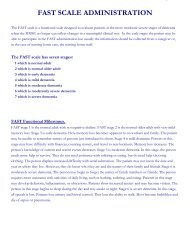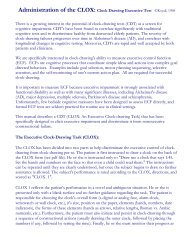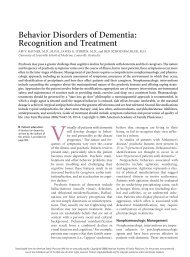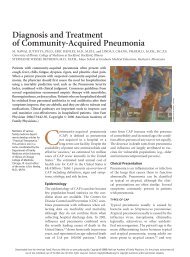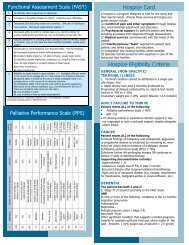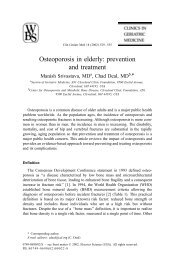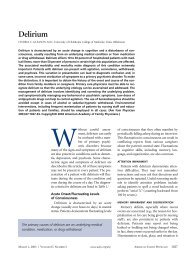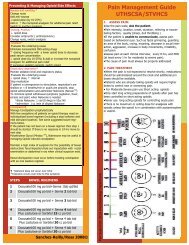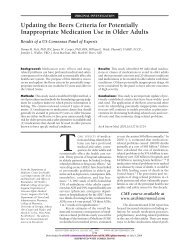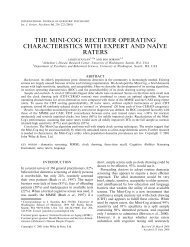Diagnosis and Treatment of Osteoporosis
Diagnosis and Treatment of Osteoporosis
Diagnosis and Treatment of Osteoporosis
Create successful ePaper yourself
Turn your PDF publications into a flip-book with our unique Google optimized e-Paper software.
<strong>Osteoporosis</strong><br />
Pharmacologic <strong>Treatment</strong><br />
BISPHOSPHONATES<br />
Oral bisphosphonates inhibit osteoclastic activity <strong>and</strong><br />
are potent antiresorptive agents. R<strong>and</strong>omized clinical<br />
trials demonstrate a reduction <strong>of</strong> vertebral <strong>and</strong> hip fractures<br />
with alendronate (Fosamax) 16,33,34 <strong>and</strong> risedronate<br />
(Actonel). 17,21,33,34 Alendronate <strong>and</strong> risedronate have<br />
also demonstrated effectiveness in men 35,36 <strong>and</strong> in glucocorticoid-induced<br />
osteoporosis. 37,38 Both daily <strong>and</strong><br />
intermittent uses <strong>of</strong> ib<strong>and</strong>ronate (Boniva) have demonstrated<br />
antifracture effectiveness at the spine only. 20,34 As<br />
age increases, the NNT to prevent all types <strong>of</strong> fractures<br />
decreases. 9<br />
Weekly <strong>and</strong> monthly dosing make taking bisphosphonates<br />
easier. Nevertheless, nonadherence is problematic<br />
<strong>and</strong> is associated with worse outcomes. 39 Oral bisphosphonates<br />
must be taken with a full glass <strong>of</strong> water. A 30- to<br />
60-minute wait is required before reclining or consuming<br />
other medications, beverages, or food to lower the<br />
risk <strong>of</strong> upper gastrointestinal adverse effects.<br />
The optimal length <strong>of</strong> oral bisphosphonate therapy is<br />
unknown. A recent study found that women who take<br />
alendronate for five years followed by five years <strong>of</strong> placebo<br />
have no increase in the incidence <strong>of</strong> nonvertebral or hip<br />
fractures compared with women who take alendronate<br />
for 10 years. There is, however, an increase in vertebral<br />
fractures. 40 This suggests that relatively low-risk women<br />
(i.e., no personal history <strong>of</strong> vertebral fractures <strong>and</strong> only<br />
modestly reduced T-score) may consider an interruption<br />
in bisphosphonate treatment.<br />
The intravenous bisphosphonates currently approved<br />
by the FDA for the treatment <strong>of</strong> postmenopausal osteoporosis<br />
are zoledronic acid (Reclast), given 5 mg yearly<br />
(shown to decrease vertebral <strong>and</strong> hip fractures), 18,34 <strong>and</strong><br />
ib<strong>and</strong>ronate, given 3 mg every three months (shown<br />
only to increase BMD in the intravenous form; the oral<br />
form has been shown to decrease vertebral fractures). 41<br />
Although the cost <strong>of</strong> these medications is high, use may<br />
prove to be an attractive strategy for high-risk patients<br />
who are unable to tolerate or are noncompliant with<br />
oral therapy, or those currently hospitalized for hip<br />
fracture.<br />
Recent concerns have been raised about the association<br />
<strong>of</strong> bisphosphonates with osteonecrosis <strong>of</strong> the jaw. To<br />
date, this rare complication is most <strong>of</strong>ten associated with<br />
the frequent infusion <strong>of</strong> intravenous bisphosphonates in<br />
patients with cancer. 42<br />
RALOXIFENE<br />
Raloxifene (Evista), a selective estrogen receptor modulator,<br />
is approved for the treatment <strong>of</strong> postmenopausal<br />
osteoporosis. Raloxifene has estrogen agonist activity on<br />
the bones <strong>and</strong> lipids, <strong>and</strong> an estrogen antagonist effect on<br />
the breast <strong>and</strong> uterus. Raloxifene is effective for reducing<br />
the incidence <strong>of</strong> vertebral fractures, but effectiveness at<br />
the hip has not been shown. 22,33,34 Raloxifene is commonly<br />
associated with increased vasomotor symptoms. Although<br />
raloxifene increases the risk <strong>of</strong> venous thromboembolism,<br />
it is indicated to decrease the risk <strong>of</strong> invasive breast cancer<br />
in postmenopausal women with osteoporosis. Perhaps it<br />
may be best used in postmenopausal women with osteoporosis<br />
who are unable to tolerate bisphosphonates, have<br />
no vasomotor symptoms or history <strong>of</strong> venous thromboembolism,<br />
<strong>and</strong> have a high breast cancer risk score.<br />
CALCITONIN<br />
Calcitonin nasal spray (Miacalcin) is an antiresorptive<br />
agent approved for the treatment <strong>of</strong> postmenopausal<br />
osteoporosis at a dosage <strong>of</strong> 200 IU in alternating nostrils<br />
each day. It is shown to decrease the occurrence <strong>of</strong> vertebral<br />
compression fractures, but not nonvertebral or hip<br />
fractures. 23,34 Although calcitonin has modest analgesic<br />
properties in the setting <strong>of</strong> acute <strong>and</strong> chronic vertebral<br />
compression fracture, 43 it is not considered first-line<br />
treatment for osteoporosis because more effective medications<br />
are available. 7<br />
TERIPARATIDE<br />
Teriparatide (Forteo) is a recombinant human parathyroid<br />
hormone with potent bone anabolic activity. In a<br />
dosage <strong>of</strong> 20 mcg per day given subcutaneously for up to<br />
two years, teriparatide decreases vertebral <strong>and</strong> nonvertebral<br />
fractures. 24,34 Adverse effects may include orthostatic<br />
hypotension, transient hypercalcemia, nausea,<br />
arthralgia, <strong>and</strong> leg cramps. Increased risk <strong>of</strong> osteosarcoma<br />
is seen in rats exposed to high doses. Consequently,<br />
teriparatide is contraindicated in patients with risk <strong>of</strong><br />
osteosarcoma, such as those with Paget disease, previous<br />
skeletal radiation, or unexplained elevation <strong>of</strong> alkaline<br />
phosphatase level. Teriparatide is approved for the treatment<br />
<strong>of</strong> postmenopausal women with severe bone loss,<br />
men with osteoporosis who have a high risk <strong>of</strong> fractures,<br />
<strong>and</strong> persons who have not improved on bisphosphonate<br />
therapy. One study suggests that it is advisable to follow<br />
teriparatide therapy with bisphosphonate therapy to<br />
maintain BMD gained. 44<br />
HORMONE THERAPY<br />
The Women’s Health Initiative confirmed that estrogen,<br />
with or without progesterone, slightly reduced the risk<br />
<strong>of</strong> hip <strong>and</strong> vertebral fractures, but found that this benefit<br />
did not outweigh the increased risk <strong>of</strong> stroke, venous<br />
198 American Family Physician www.aafp.org/afp Volume 79, Number 3 ◆ February 1, 2009



